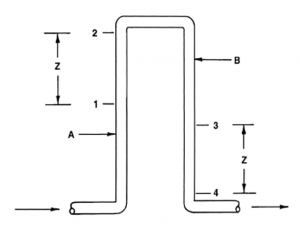Most slurries are abrasive and corrosive in nature, and it is difficult to make instrumentation accurate and reliable. For proper functioning of instruments, selection, installation, calibration, and maintenance of instruments must be properly taken care of. Basic instrumentation is primarily necessary for safe operation and trouble-shooting. More extensive instrumentation is needed to maximise output and achieve cost-effective operation. In most situations, it is preferable to obtain measurements inline, i.e., via instruments installed in a pipeline through which the slurry is flowing. Among the measurements most often sought are flow rate, solid concentration and density, pump power, and pressure.
The important parameters for systematic control are flow rate and solid concentration.
Flow rate
A simpler device for measuring flow rate is the bend meter. A particular advantage of this technique is that it can be applied to an existing bend, and requires no additional disturbance to the slurry. The pressure difference is measured between the inside and outside of a bend. This type of device becomes less reliable if the flow is stratified, and it is therefore preferable to apply the measurement at a bend where the entering flow is vertical.
Where
To a first approximation, the slurry flow rate for a 90° bend with pressures measured at the 45° positions is as follows:

Figure: Bend meter (schematic)
It is essential to calibrate any specific bend meter against some 'absolute' measurement such as a magnetic flow meter. For precise measurement, the most widely used flow instruments are magnetic flow meters and Doppler meters. A magnetic flow meter measures total volumetric flow and is non-intrusive: i.e. it does not disturb the flow. Readings from a magnetic flow meter can be accurate to within 0.5 to 1% of full-scale reading. The reading of this instrument is affected by the presence of ferromagnetic solids, stratification, or entrained air. It is advisable to locate it in a straight vertical section of the pipe. A Coriolis flow meter is used to measure mass flow rate. A Doppler meter is also non-intrusive in nature, and uses a sensor in the pipe wall to transmit ultrasonic waves into the flow, measuring the frequency shift of waves reflected by the transported particles. The instrument is available at a relatively low cost. The demerit is that the reading is distorted by stratification. It is preferable to locate the instrument in a straight vertical pipe.
Solids concentration
For the measure of solid concentration, or equivalent parameter of mean mixture density, a U-loop device is used. The pressure gradient is measured in two vertical pipes, a “riser” and a “down comer”. Calculation of the relative density of the delivered slurry and delivered solids concentration can be done using the following formula:
Where, p1 and p4 are the static pressures in the slurry at the four measurement locations.

Figure: Schematic of inverted U loop
As an alternative, a nuclear densitometer can be used to measure slurry density, which relies on the attenuation of gamma-rays passing through the slurry. The parameter measured is the mean density along the radiation path, which indicates the in-situ density rather than the delivered value. In a stratified flow, the reading will depend on the location of the gamma-ray beam within the slurry. A radiation densitometer is best installed on a straight vertical section of pipe.
Pump power
Performance diagnosis can be done with pump power. For direct measurement of pump input power, it is preferable to use a separate torque bar installed in the drive coupled with a magnetic speed pickup. The torque bar may be of the strain gauge type, set up with a conditioner unit and multiplier unit to show power directly. If a torque bar cannot be installed, it is possible to mount strain gauges on the drive shaft and use the wireless type of signal transmitter. Where pump power cannot be measured directly, it may be calculated from the motor power. If an electric motor is used, the current (I) indicated by an ammeter enables the motor power to be estimated as:
where E is the voltage of the supply, θ is the phase angle between voltage and current, and η is the efficiency of the motor. For a fully loaded motor, cosθ can be taken as 0.8 and η as 0.9. Two-element type wattmeter, using current and potential transformers, gives P more accurately, because they automatically correct for changes in θ and E.
Pressure sensors
Pressure sensors such as direct coupling, diaphragm seals, and elastomeric sleeves are used. Differential pressure transducers of the capacitance type are preferred for the measurement of pressure loss. There are many commercially available designs of on-line instruments to measure viscosity of slurry. On-line capillary viscometers are relatively inexpensive and widely used. Vibrational viscometers, rotational viscometers, coaxial cylinder viscometers, and capillary tube viscometers are also used based on the availability of the instrument and the property of the fluid.
Data-logging
Multi-channel analogue-to-digital converters and computer data logging systems are available, which allow real-time visualization of the full performance of a system. With use of such instruments, the stability of the system can be monitored continuously, to ensure that measurements are only made when operation is steady.
Although proper selection of instruments is a must, the overall design of the total system, together with proper selection of pumps, must be considered for optimum reliability.
We aim to provide responsive service. Please contact us and
we will do our best to address your query: